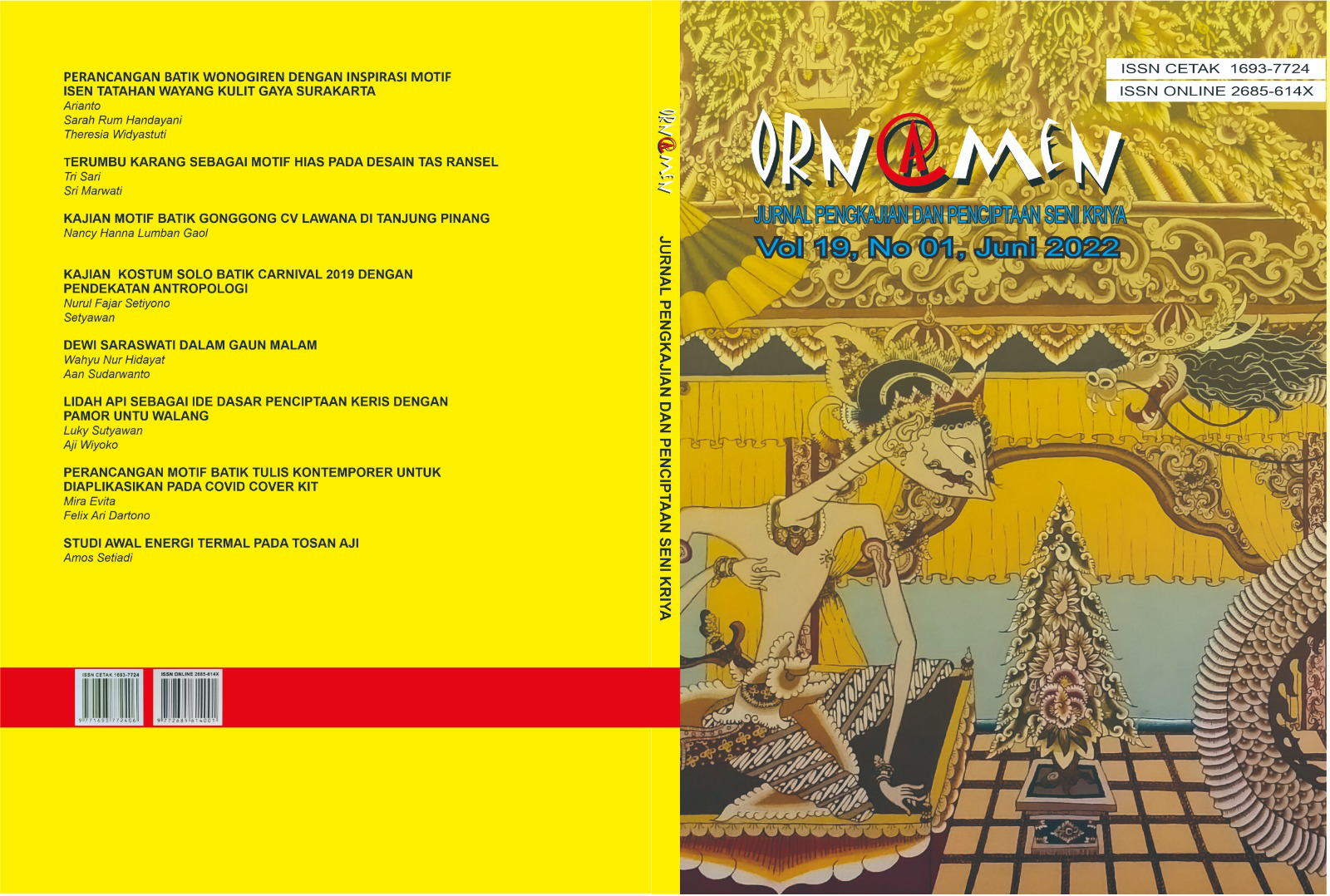KAJIAN MOTIF BATIK GONGGONG CV LAWANA DI TANJUNG PINANG
DOI:
https://doi.org/10.33153/ornamen.v19i1.3904Keywords:
Batik Gonggong, Batik Gonggong CV Lawana, Malay Batik creationsAbstract
Gonggong CV Lawana in Tanjung Pinang using a textile design method approach. This research is formulated in one question "How is the design of the Batik Gonggong motif in the Production of Batik Gonggong CV Lawana, Tanjung Pinang with a textile design method approach through aesthetic, material, process, function, and fashion aspects?". This research uses a descriptive qualitative research method with a textile design method approach. Data analysis techniques using interactive analysis models include data reduction, data presentation, and concluding. The results of the research reveal the stages that are passed in designing based on aesthetic aspects, materials, process functions, and supporting aspects, namely fashion. (1) The aesthetic aspect that is considered in the main and supporting motifs, especially the main motif of Batik Gonggong CV Lawana has identical characteristics with the character of a snail shell that bulges in its belly. (2) The material aspect is a consideration in selecting the type of yarn fiber, the structure of the weave, nature and absorption capacity or suitability of the fabric as well as the different alternative fabrics for stamped and written batik products. (3) The process aspect of Batik Gonggong begins with determining the design from the main source of inspiration, the shell of the barking snail, the design will go through a sublimation process, then continue to be produced in certain quantities. (4) Functional aspects are related to consumers who use the product as a choice of use, as regional souvenirs, uniforms, and fashion. (5) The fashion aspect is found in the development of motifs through three periods ranging from natural suggestion patterns, creative patterns, and combined patterns. The development of the coloring technique, namely gradation is done by brushing using a sponge with a combination of giving light and dark colors which when soaked will fade and produce a gradation effect.Downloads
References
Asti, Musman & Arini B, Ambar. 2011. “Warisan Adiluhung Nusantara”. Yogyakarta: ANDI.
Enita, Ria. 2014. Skripsi “Redesain Motif Pucuk Rebung Kuntum Mambang dengan Teknik Emoss”. Universitas Telkom.
Malik, Haji Abdul. 2012. “Menjemput Tuah Menjunjung Marwah.”. Depok: PT. Komodo Books.
Rizali, Nanang. 2012. “Metode Perancangan Teksil.” Surakarta: UNS Press.
Sulistiyowati, Amin. 2017. Jurnal “Estetika Batik Pedesaan Bekonang Sukoharjo.” Jurnal Akademi Seni dan Desain Indonesia Surakarta Vol. 4 No. 1 Tahun 2017.
Sutjiatiningsih, Sri & Winoto, Gatot. 1999. “Kepulauan Riau Pada Masa Dollar.”. Jakarta: CV. Ilham Bangun Karya.
Viruly, Linda. 2011. “Pemanfaatan Siput Laut Gonggong (Strombus canarium) Asal Pulau Bintan-Kepulauan Riau Menjadi Seasoning Alami.”. Bogor: Institut Pertanian Bogor.
Wulandari Ari. 2011. “Batik Nusantara: Makna Filosofis, Cara Pembuatan & Industri Batik.” Yogyakarta: C.V Andi Offset.
Yanti, Siska. 2017. “Potensi dan Pola Pemanfaatan Siput Gonggong di Perairan Pesisir Desa Pangkil Tanjungkeramat Kecamatan Teluk Bintan Kabupaten Bintan Provinsi Kepulauan Riau.” Fakultas Ilmu Kelautan dan Perikanan. Universitas Maritim Raja Ali Haji.
Yudoseputro, Wiyoso. 2008. “Jejak-Jejak Tradisi Budaya Rupa Indonesia Lama”. Yayasan Seni Visual Indonesia.
Downloads
Published
Issue
Section
License
Copyright Notice
Authors who publish with Ornamen agree to the following terms:
- Authors retain copyright and grant the journal the right of first publication with the work simultaneously licensed under a Creative Commons Attribution License (CC BY-SA 4.0) that allows others to share the work with an acknowledgment of the work's authorship and initial publication in this journal.
- Authors are able to enter into separate, additional contractual arrangements for the non-exclusive distribution of the journal's published version of the work (e.g., post it to an institutional repository or publish it in a book), with an acknowledgment of its initial publication in this journal.
- Authors are permitted and encouraged to post their work online (e.g., in institutional repositories or on their website) prior to and during the submission process, as it can lead to productive exchanges, as well as earlier and greater citation of published work.

This work is licensed under a Creative Commons Attribution-ShareAlike 4.0 International License.







